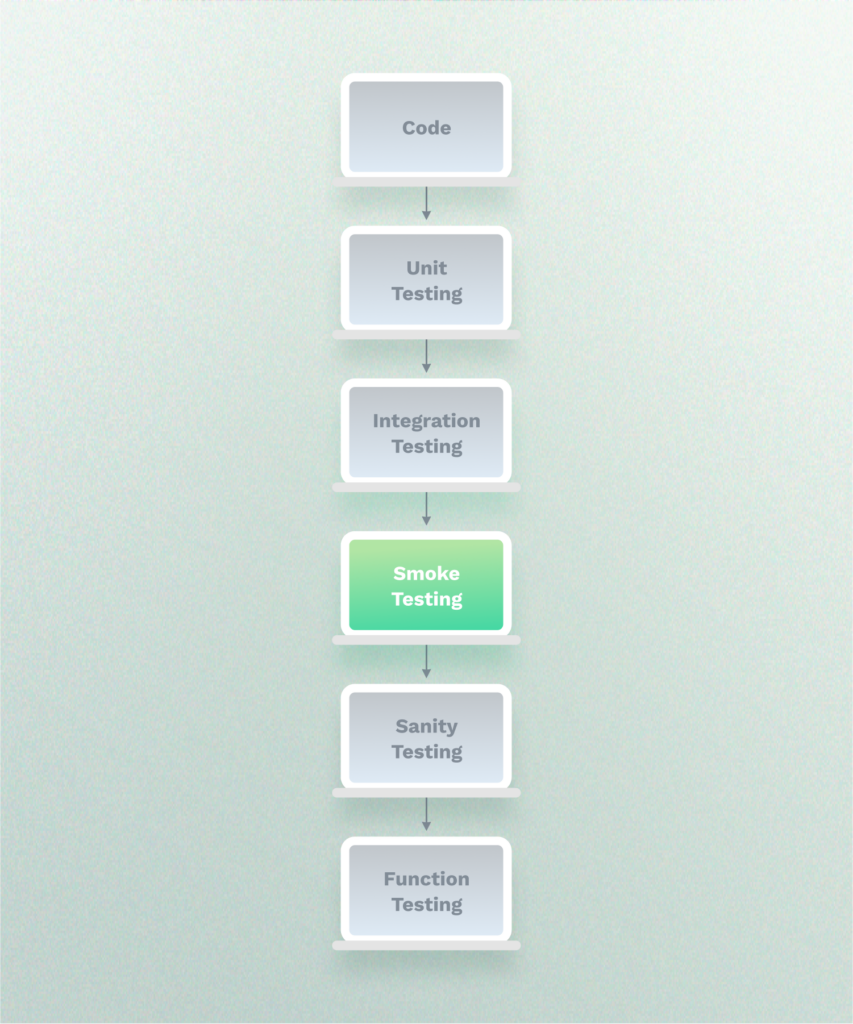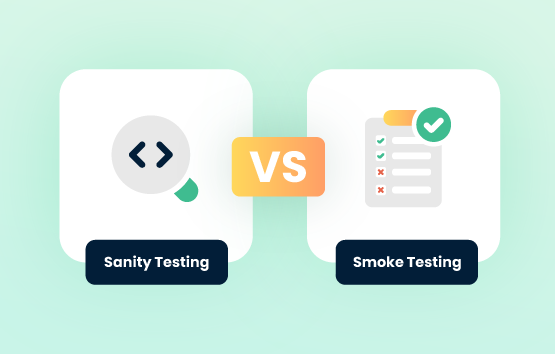Say you’re a new developer, and you were just hired to test an e-Commerce website before it goes live. You want to make sure that the login function is working. Is it time for a smoke test or a sanity test? Well, it depends.
If a login bug was recently fixed, then you’ll want to run a sanity test to check whether users can successfully log in with valid credentials or if the bug broke the login’s functionality.
If there was no fix and instead, you’re doing a quick check to confirm that the site’s core features like login, product search, or checkout are working after a new build, that would be considered a smoke test. It helps determine whether the website’s basic functionality is intact.
Smoke tests keep things more broad, aiming to catch the major problems before time can be wasted troubleshooting the minor ones. In other words, you don’t want to waste time troubleshooting one button that isn’t responsive if the entire screen is broken. Sanity tests, on the other hand, have a more focused aim. They’re done as a way of checking your work after a specific issue has been fixed.
Today we’ll be breaking down smoke testing vs sanity testing. We’ll detail their definitions, differences, uses, and how to automate them to speed up your work processes.
Ready? Let’s dive in.
Table of Contents
- What is smoke testing?
- What is sanity testing?
- Smoke Testing vs Sanity Testing: A Side-by-Side Comparison
- Who runs smoke tests and sanity tests?
- Benefits of automating smoke testing and sanity testing
- Automate smoke testing and sanity testing with Ghost Inspector
Build automated smoke tests and sanity tests
with Ghost Inspector
Our 14 day free trial gives you and your team full access. Create tests in minutes. No credit card required.
What is smoke testing?
Smoke testing is a type of software testing that determines whether the most basic functions of an application are working properly after a new build. This testing type helps testers to quickly decide whether a build is stable enough for more in-depth testing.
For QA testers, smoke testing helps confirm if there’s a major failure, saving time by avoiding extensive testing on a broken build. For example, if you’re testing an e-commerce website, a smoke test might involve verifying that products are being displayed correctly and that product pages can be opened easily. If there’s an issue at this basic level, then the build must be re-examined before deeper testing can begin. Smoke tests are often automated in web testing to quickly confirm core features after each deployment.
What is sanity testing?
Sanity testing is a type of software testing that verifies whether specific parts of a software work correctly after small changes or bug fixes are made. Sanity testing usually serves as a sort of checkpoint to decide whether more detailed testing is needed. For QA testers, sanity testing is used to determine whether recent updates have broken any of the core features of an application.
For example, if an e-commerce website’s shopping cart starts glitching, once it’s fixed, a QA tester might conclude the troubleshooting process by running a sanity test to make sure that everything is working correctly again. The sanity test would likely involve three actions:
- Adding a product to the cart
- Updating the quantity
- Confirming the total price
If the test runs smoothly, testers can move on to more in-depth regression testing from there. Sanity testing is especially useful in fast-paced development cycles, because it serves as quick validation that the software is working as it should. In web testing, sanity testing often gets automated to save time and prevent downtime through an increased number of deployments.

Smoke Testing vs Sanity Testing: A Side-by-Side Comparison
| Aspect | Smoke Testing | Sanity Testing |
| What does it do? | Determines whether the major features of a new build work | Confirms specific bug fixes or other small changes |
| When is it used? | After a new build or major release | After a minor update or bug fix |
| What’s the scope? | Broad scope, covering the entire system | Narrow scope, focusing only on the changed or affected parts |
| How detailed is it? | Basic-level checks to verify stability | Deep-level checks on a specific area |
| What’s the testing goal? | To determine if the build is stable enough for further testing | To confirm that a fix or change is working correctly |
| Can you automate it? | Yes! Great for automated checks in CI/CD pipelines | Yes! Great for quickly validating fixes |
Who runs smoke tests and sanity tests?
In most testing environments, both smoke tests and sanity tests are run by the QA team. It’s usually up to Quality Assurance to trigger these two testing types, so they can catch any issues that arise before the developer team gets held up. However, developers run these tests as well, especially when they’re integrated into a CI/CD pipeline.
In automated web testing, the testing team might choose to deploy a smoke test immediately after any build is pushed or to automatically run sanity testing as part of validation after a bug fix. Regardless of who initiates them, the QA team usually owns the test coverage and is responsible for reviewing the results and escalating any issues they catch.
Benefits of automating smoke testing and sanity testing
There are many benefits to automating both smoke and sanity testing. First, it helps guarantee that any issues get caught within minutes of a deployment or code change. It also helps teams to provide consistent, reliable software without any risk of problems due to human oversight during manual testing. And by freeing up the dev and QA teams from having to run manual tests, it increases productivity levels across the board, allowing both teams to take on more complex testing and development tasks.
And for teams working with CI/CD workflows, automation helps provide continuous validation into the pipeline, allowing for continuous monitoring of your software at every stage. Altogether, these benefits provide testing teams with more confidence in their work and a faster overall development cycle
Automate smoke testing and sanity testing with Ghost Inspector
With Ghost Inspector, you can easily automate the software testing process by building and scheduling browser tests that mimic real user interactions on your website or web app. The best part? You don’t need to be a coding expert to get started. With features like a visual test recorder and drag-and-drop test editor, anyone can create and maintain automated tests.
Ghost Inspector makes automating smoke and sanity testing simple, especially for teams working with modern web apps and CI/CD pipelines. For smoke testing, you can schedule a test suite to run immediately after each deployment that checks core functionalities like loading the homepage, logging into an account, or submitting a form.Tests can run automatically after a deployment or code change, thanks to built-in integrations with tools like GitHub Actions or Jenkins.
For sanity testing, you can build and automate focused tests tied to specific components or bug fixes. For example, if a recent patch was made to the checkout process, you could create a Ghost Inspector test by clicking through the checkout process to verify that the updates work correctly. These tests can be triggered automatically via your CI/CD pipeline or through API calls for an even smoother testing workflow.
Ghost Inspector’s other features include:
- Advanced end-to-end testing capabilities
- Compatibility across various browsers and devices for greater testing flexibility
- Automated visual regression testing through captured testing screenshots and reports
- Instant alerts via email, Slack, and other integrations when anything breaks
- Reusable components and test environments to help maximize your test coverage
- Scheduling and continuous monitoring, allowing tests to run at set intervals
- Seamless CI/CD integration with tools like Jenkins, CircleCI, and GitHub Actions
- Data-driven testing through CSV uploads or external data sources to cover a wide range of input scenarios
- Detailed test result history and versioning to help teams track changes and regressions over time
And more!
If you’re looking for the simplest way to implement test automation for smoke testing, sanity testing, and any other stages of the testing process, Ghost Inspector helps democratize test-building, so anyone on your team can run comprehensive testing, regardless of coding ability.
Automate smoke testing and sanity testing
with Ghost Inspector
Our 14 day free trial gives you and your team full access. Create tests in minutes. No credit card required.


